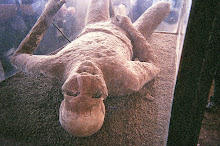
 Have you ever seen one of those old time gladiator movies? You know, like Spartacus. Well, all those cheesy movies falsely describe gladiators! It's all blather, balderdash, poppycock, INSANITY! To honor gladiators, I will reveal the true story, of their lifestyle.
Have you ever seen one of those old time gladiator movies? You know, like Spartacus. Well, all those cheesy movies falsely describe gladiators! It's all blather, balderdash, poppycock, INSANITY! To honor gladiators, I will reveal the true story, of their lifestyle.To begin with, gladiators fought barefoot because so-called "gladiator sandals" would make it harder to keep their balance. Gladiators could not do whatever they wanted outside the arena. In fact, they would be flogged if caught womanizing or drinking. Finally, these men had a bland diet of beans and barley, which would build a layer of fat or insulation that could protect him against slash attacks during battle.
Dr. Karl Grosschmidt, a forensic pathologist, at the University of Vienna analyzed gladiator bones found in a Roman gladiator graveyard in Ephesus. Of particular interest, was a tombstone that depicted a man holding the palm leaf, the symbol of the champion. The dead gladiator's name was Polombus and he was not a slave. Gladiatorial fights started as funeral rites performed by a few slaves and spilling blood honored the dead. By Caesar's time, many gladiator schools had been built and opened. Polombus went to one of these schools and survived the training. The special thing about Polombus is that he started a new generation of gladiators. Gladiators that fought for money.
It was discovered that Polombus was a Murmillo gladiator. A Murmillo was taken from the Greek word, mormylos or fish because of the fish-like shape of their helmets. . The Murmillo's nemesis was the Thracian, who carried a deadly curved sword and a square shield. Polumbus may have also fought a Retiarius who wore little armor. They brandished a trident and net. The Retiarii were the only gladiators with no helmet.
After analyzing more and more bones, Dr. Grosschmidt found four tiny pinpricks on some of the bones. There was no known weapon wielded by a gladiator that made markings like that. A quadrant weapon must have been used in the arena to cause this pattern of injury to the bones of gladiators. After x-raying these bones from the graveyard in Ephesus, it appears from the healed bones that gladiators received good medical care. It was expensive to train and feed these fighters and it would not be smart to have them disabled after a fight.
If a gladiator was very successful in the arena, he was treated like a "movie star." He could have his name on products for sale. Children might play with a "gladiator action figure." As long as you could stay alive in the arena, you could retire with a comfortable savings.
I close with the gladiator salute, "Nos morituri te salutamus."




No comments:
Post a Comment